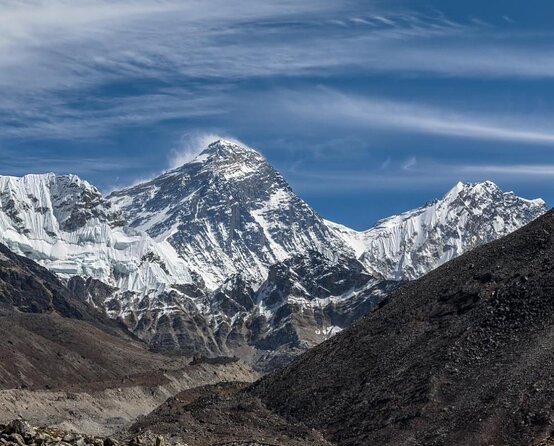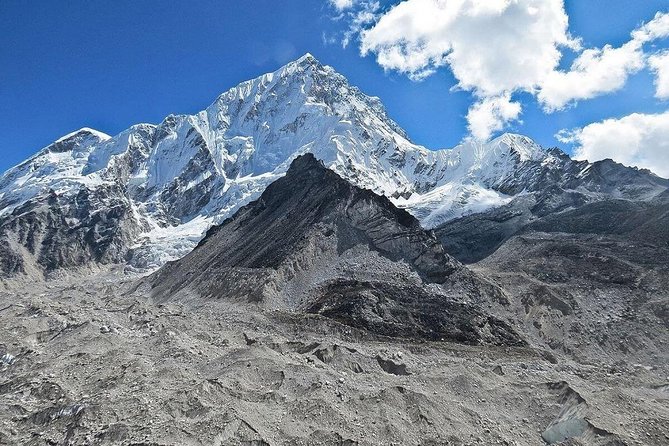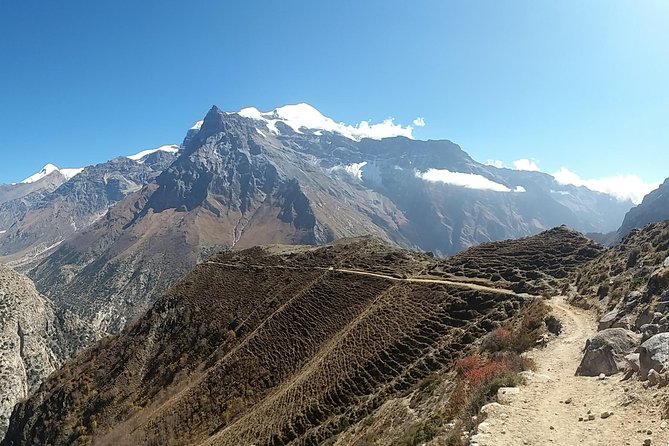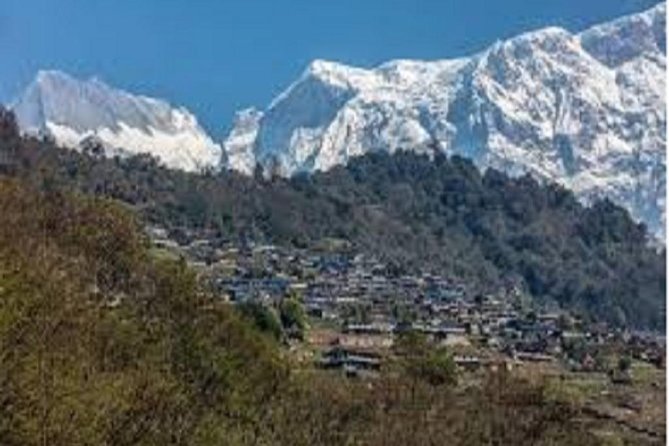Sailung Trek 15 D/14N
Set out on an exclusive journey through the captivating landscapes of the Sailung region with the Sailung Trek, a 15-day expedition that offers a blend of cultural encounters and awe-inspiring natural vistas.
Beginning in Kathmandu, Nepal, this trek presents varying degrees of challenge and a chance to reach heights of 3,146 meters while relishing panoramic Himalayan views. Trekkers can anticipate seeing the local Tamang culture, with options for both comfortable tea house stays and camping adventures.
The guidance of seasoned local experts ensures a safe and enriching experience as participants traverse through charming villages, visit Buddhist monasteries, and encounter diverse flora and fauna.
Key Points

- Trek through Sailung region for 15 days, experiencing moderate to challenging terrain.
- Immerse in local Tamang culture, visit monasteries, and witness diverse flora and fauna.
- Ensure safety with experienced guides, altitude sickness precautions, and emergency plans in place.
- Enjoy Nepali cuisine, panoramic Himalayan views, and sustainable trekking practices for a memorable experience.
Here's some more nearby activities we've reviewed
Trek Duration and Difficulty

When embarking on the Sailung Trek, visitors should be prepared for a 15-day journey of moderate to challenging difficulty through the picturesque Sailung region starting from Kathmandu, Nepal. Fitness preparation is essential as the trek requires moderate to high fitness levels due to uphill and downhill sections. It’s advisable to engage in regular exercise before the trek to ensure readiness.
Acclimatization days are strategically included in the itinerary to help trekkers adjust to the altitude gradually, reducing the risk of altitude sickness. Along the way, travelers will have the opportunity to enjoy the local culture, learn about Tamang traditions, and if timing permits, participate in local festivals.
This blend of physical challenge and culture makes the Sailung Trek a truly unique experience.
Starting Point and Altitude

As trekkers embark on the Sailung Trek, they’ll commence their 15-day journey from the vibrant city of Kathmandu, Nepal, before gradually ascending to a maximum altitude of 3,146 meters in the picturesque Sailung region. Altitude acclimatization is crucial as they climb through diverse landscapes, ensuring a safe and enjoyable experience.
Along the way, trekkers can savor local cuisine, experiencing traditional Nepali flavors and culinary delights. Cultural interactions with the Tamang communities provide insight into local traditions, while also highlighting the importance of minimizing environmental impact.
Detailed Itinerary Overview

Embarking on the Sailung Trek entails a meticulously crafted 15-day journey through the stunning landscapes of the Sailung region, offering a blend of adventure and culture.
- Engage in local festivals and cultural interactions
- Visit Buddhist monasteries for insights into traditional practices
- Interact with Tamang communities to learn about their way of life
- Experience the unique flora and fauna of the region
- Enjoy traditional Nepalese culture and daily village life
The itinerary is thoughtfully designed to provide a comprehensive experience that combines the thrill of trekking with opportunities to engage deeply with the local culture, witness age-old traditions, and marvel at the natural beauty of Sailung.
Accommodation Options Available
For trekkers exploring the Sailung region, various accommodation options are available, catering to different preferences and needs. Along the trek, trekkers can opt for lodging in tea houses offering basic facilities and shared rooms. These tea houses provide a cozy and communal atmosphere, allowing trekkers to interact with fellow adventurers.
For those seeking a more adventurous experience, camping alternatives are also available, providing a closer connection to nature. However, it’s important to note that while these accommodations offer unique experiences, they may come with limited facilities such as access to electricity and hot water.
Trekkers should be prepared for a more rustic living experience while enjoying the beauty of the Sailung region.
Trek Highlights to Look For
Exploring the Sailung region offers trekkers a chance to witness breathtaking panoramic views of the Himalayas and enjoy the rich culture of local Tamang communities.
-
Local festivals: Engage in vibrant local celebrations if timing aligns with festivals.
-
Monastery visits: Explore Buddhist monasteries and interact with resident monks for a spiritual experience.
-
Flora and fauna: Encounter unique plant and animal species along the trekking route.
-
Cultural exchanges: Experience traditional Nepalese customs through interactions with villagers.
-
Community immersion: Gain insights into the daily life of the Tamang people through authentic experiences.
Essential Packing List Items
Packing for the Sailung Trek requires essential items to ensure a comfortable and safe journey through the Himalayan landscapes. Gear essentials such as warm clothing layers, hiking boots, water purification tablets, and a first aid kit are crucial for the trek.
Trekking tips suggest packing light to ease the journey and prioritize items based on necessity. Utilize packing hacks like rolling clothes to save space in your backpack. Don’t forget trail snacks to keep up your energy levels during long hikes.
Having a camera handy will allow you to capture the breathtaking views along the way. By being well-prepared with these packing essentials, trekkers can fully enjoy the Sailung adventure.
Role of the Trekking Guide
Navigating the rugged terrain and cultural nuances of the Sailung Trek, the trekking guide plays a pivotal role in ensuring a safe and enriching experience for adventurers. The role of guides includes:
- Providing valuable insights about the region’s history and culture
- Ensuring the safety of trekkers along the challenging trekking routes
- Facilitating meaningful cultural interactions with local communities
- Sharing knowledge about the flora, fauna, and geography of the area
- Assisting with language barriers and enhancing communication during the journey
With their expertise and guidance, trekking guides not only lead the way but also enhance the overall experience by fostering culture and creating memorable moments for trekkers.
Meals and Dietary Options
Enhancing the trekking experience, the meals provided on the Sailung Trek offer a taste of authentic Nepali cuisine with a variety of dietary options to accommodate different preferences.
Exploring local cuisine is a highlight, allowing trekkers to savor traditional Nepali dishes while seeing the culture. Vegetarian and non-vegetarian choices are available, ensuring that all dietary needs are met.
Hygienic food preparation practices are followed to maintain the well-being of trekkers. Special dietary requirements can be accommodated upon prior notice, guaranteeing a comfortable and enjoyable dining experience.
At altitude, maintaining proper hydration is crucial, and the meals are designed to support trekkers in this aspect. The combination of flavorful local cuisine and dietary flexibility enhances the overall trekking journey.
Transportation Details
When embarking on the Sailung Trek, trekkers will experience a mix of private vehicle transfers from Kathmandu to the trek start point and scenic drives through picturesque landscapes, enhancing the overall journey through the Sailung region. Along With these conveniences, they may encounter some transportation challenges and have the opportunity to enjoy local transportation experiences.
- Narrow mountain roads: Some sections may be narrow and winding, requiring cautious navigation.
- Local buses: Trekkers might’ve the chance to travel on local buses, offering a glimpse into everyday Nepalese commuting.
- Off-road paths: Parts of the journey may involve off-road paths, adding an adventurous touch to the transportation.
- Shared jeeps: Shared jeep rides could be a mode of transport, fostering a sense of community among travelers.
- Scenic pit stops: The journey may include stops at scenic viewpoints, allowing for moments of awe and relaxation.
Safety Measures Implemented
Ensuring trekkers’ safety throughout the Sailung Trek involves proactive measures and expert guidance. Safety precautions such as altitude sickness awareness, emergency evacuation plans, and experienced guides trained in first aid are in place. Trekking in groups further enhances safety, while continuous weather monitoring ensures safe trekking conditions. Here is a breakdown of the safety measures implemented:
| Safety Measures | Details |
|---|---|
| Altitude Sickness | Awareness and prevention strategies |
| Emergency Evacuation | Plans in place for swift actions |
| Safety Precautions | Proactive measures for trekker safety |
| Weather Monitoring | Continuous monitoring for safe conditions |
These measures work together to create a secure environment for trekkers throughout the Sailung Trek.
Necessary Permits for the Trek
For a seamless experience during the Sailung Trek, acquiring the necessary permits is essential. Understanding permit regulations and local customs is crucial to ensure compliance and respect for the region’s traditions. Plus, being mindful of the environmental impact and embracing cultural exchange enriches the overall trekking experience.
Here are some key points to consider:
- Obtain TIMS (Trekkers’ Information Management System) card.
- Secure National Park entry permits.
- Confirm that permits are organized by the tour operator.
- Ensure permit costs are included in the trek package.
- Adhere to legal requirements to maintain the integrity of the trek and support sustainable tourism practices.
Ideal Weather Conditions
To fully enjoy the Sailung Trek experience, understanding the ideal weather conditions becomes paramount for a safe and memorable journey through the Himalayan landscapes. It’s crucial to take weather precautions and pack seasonal gear for varying climate changes along the trek.
Daytime temperatures typically range from 10°C to 20°C, but nighttime temperatures can drop below freezing, with the possibility of rain and snowfall. Trekkers should be prepared for these fluctuations and sudden weather changes. Carrying appropriate clothing layers, including warm gear for cold nights, is essential.
Plus, for enthusiasts looking to capture stunning trek photography, being ready to adapt to the weather conditions will ensure great shots amidst the breathtaking scenery.
Fitness Level Requirements
With moderate to high fitness levels required, individuals embarking on the Sailung Trek should consider regular exercise before the journey to tackle the uphill and downhill sections with ease. It’s advisable to focus on fitness training to prepare adequately for the trek. Altitude acclimatization is crucial for a safe and enjoyable experience at higher elevations.
Here are some key points to consider:
- Regular Exercise: Prioritize cardio and strength training.
- Proper Gear: Invest in quality hiking boots and gear.
- Hydration: Stay well-hydrated throughout the trek.
- Healthy Diet: Maintain a balanced diet for energy.
- Rest and Recovery: Listen to your body and take breaks when needed.
Cultural Immersion Opportunities
Enjoy the rich cultural tapestry of the Sailung region through engaging with local traditions and daily life experiences. Get a glimpse of Nepali traditions by participating in local festivals if your timing aligns with these vibrant events.
Visit Buddhist monasteries along the trek, where you can interact with monks and learn about their way of life. Experience the warmth of Nepalese villages as you observe daily routines and customs, offering you a deeper understanding of the local culture.
Don’t miss the chance to pick up basic Nepali phrases and engage with the friendly locals, enriching your cultural journey through Sailung’s fascinating heritage.
Focus on Sustainability
Explore the sustainable practices embraced in the Sailung region, fostering a harmonious relationship between nature and tourism.
- Sustainability practices:
- Implementing Leave No Trace principles
- Respecting local customs and traditions
- Supporting the local economy through tourism
- Minimizing environmental impact during the trek
- Carrying reusable water bottles to reduce plastic waste
Community engagement opportunities are integral to ensuring that the Sailung Trek benefits both visitors and locals alike. By actively participating in sustainable initiatives and respecting the local way of life, trekkers contribute positively to the region’s long-term well-being. This focus on sustainability not only preserves the natural beauty of Sailung but also enriches the cultural experience for all involved.
Here's a few more nearby tours and experiences we have reviewed.
- Kathmandu: Mount Everest Scenic Tour by Plane With Transfers
- Kathmandu: City Flavors Guided Walking Tour
- Spiritual Nepal: Expert Insight Into Hinduism and Buddhism
- Experience Luxury Travel: Pokhara to Kathmandu by Sofa Bus
- From Kathmandu: Nagarkot Panoramic Day Hike With Lunch
- Kathmandu: Private One Day Nagarkot Sunrise and Hiking Trip
Common questions
Are There Any Specific Rules or Etiquette to Follow When Interacting With the Local Tamang Communities During the Sailung Trek?
When interacting with local Tamang communities, visitors should respect their customs and traditions. Communication should be approached with openness and respect. Learning basic Nepali phrases can enhance the experience, fostering cultural exchange and mutual understanding.
What Types of Wildlife Can Be Spotted in the Sailung Region, and Are There Any Precautions to Take While Encountering Them?
Wildlife sightings in the Sailung region include Himalayan birds, langur monkeys, and occasional deer. Trekkers should maintain a safe distance, avoid feeding or approaching animals, and heed guide instructions. Respectful observation enhances the trekking experience while ensuring safety.
How Are Emergency Situations Handled During the Trek, and What Measures Are in Place for Medical Emergencies?
In case of emergencies during the trek, experienced guides provide immediate medical support, follow evacuation procedures, and ensure safety protocols are in place. They are trained in first aid, equipped for altitude sickness precautions, and monitor weather for safe trekking conditions.
Can Participants Engage in Any Cultural Activities or Workshops to Learn More About Nepalese Traditions and Customs Along the Trekking Route?
Participants can engage in cultural workshops and traditional activities to learn about Nepalese customs along the trekking route. These learning opportunities include experiencing local festivals, visiting monasteries, and interacting with Tamang communities for a rich culture.
How Can Trekkers Contribute to the Sustainability Efforts and Support the Local Economy During the Sailung Trek?
Trekkers can support sustainability by following Leave No Trace principles, respecting local customs, and minimizing environmental impact. Engaging with communities, participating in cultural workshops, and supporting local businesses contribute to economic growth and cultural preservation on the trek.
Here's more of our most recent tour reviews happening neaby
- Typical Newari Old Towns Bungmati, Khokana and Kirtipur With Food Tasting Trip
- Sakhu- Nagarkot Hike
- Nagarkot to Chisapani Trek Around Kathmandu – 3 Days
- Nepal: 8 Days Kathmandu Pokhara Chitwan Tour
- Explore Entire Kathmandu City by Comfortable Private Car
- Private Guided Hiking Tour in Kathmandu
- 5 Days Chisapani Nagarkot Trek (Family Trekking)
- Annapurna Circuit Tilicho Lake Private Guided Trek
- Private 2-Day Bandipur Village Trek From Kathmandu
- Tsum Valley & Manaslu Circuit Trek
- Sunrise Tour to Nagarkot
Last Words
Embark on the Sailung Trek for an unforgettable 15-day journey filled with breathtaking views and culture in Nepal’s stunning landscapes.
With experienced guides, safe trekking measures, and a mix of tea house stays and camping options, this adventure promises a truly memorable experience.
Explore picturesque villages, Buddhist monasteries, and interact with local Tamang communities for a once-in-a-lifetime trekking experience.
Don’t miss the chance to create lasting memories in the heart of Nepal’s enchanting Sailung region.